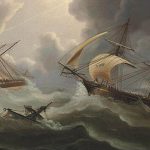 Music
Music  Music
Music  History
History 10 Less Than Jolly Events That Occurred on December 25
 Weird Stuff
Weird Stuff 10 Funny Ways That Researchers Overthink Christmas
 Politics
Politics 10 Political Scandals That Sent Crowds Into the Streets
 Weird Stuff
Weird Stuff Ten Bizarre Facts About The Doge Meme
 Our World
Our World 10 Ways Your Christmas Tree Is More Lit Than You Think
 Movies and TV
Movies and TV The 10 Coolest Stars to Set Sail on The Love Boat
 History
History 10 Things You Didn’t Know About the American National Anthem
 Technology
Technology Top 10 Everyday Tech Buzzwords That Hide a Darker Past
 Humans
Humans 10 Everyday Human Behaviors That Are Actually Survival Instincts
 Music
Music 10 Surprising Origin Stories of Your Favorite Holiday Songs
 History
History 10 Less Than Jolly Events That Occurred on December 25
 Weird Stuff
Weird Stuff 10 Funny Ways That Researchers Overthink Christmas
Who's Behind Listverse?

Jamie Frater
Head Editor
Jamie founded Listverse due to an insatiable desire to share fascinating, obscure, and bizarre facts. He has been a guest speaker on numerous national radio and television stations and is a five time published author.
More About Us Politics
Politics 10 Political Scandals That Sent Crowds Into the Streets
 Weird Stuff
Weird Stuff Ten Bizarre Facts About The Doge Meme
 Our World
Our World 10 Ways Your Christmas Tree Is More Lit Than You Think
 Movies and TV
Movies and TV The 10 Coolest Stars to Set Sail on The Love Boat
 History
History 10 Things You Didn’t Know About the American National Anthem
 Technology
Technology Top 10 Everyday Tech Buzzwords That Hide a Darker Past
 Humans
Humans 10 Everyday Human Behaviors That Are Actually Survival Instincts
10 Notable Events That Also Occurred on September 11
Among Baby Boomers, members of the Silent Generation, Generation Xers, and Millennials, and the events that occurred in their lifetimes, those that occurred on September 11, 2001, had one of the most significant impacts on United States history.
The sounds, the images, the loss of life, and the acts of heroism witnessed that day make it likely that the date will stay etched in many people’s minds for a long time.
While most will agree it is important to never forget the events of September 11, 2001, other notable events occurred on that date through the years that are also worth remembering. Below, we take a closer look at some of them chronologically.
Related: The Ten Most Followed Real-Life Criminal Trials in TV History
10 Battle of Brandywine, 1777
The roughly 11,000 American troops fighting in the Revolutionary War who were stationed near Brandywine Creek in what is now the Philadelphia suburbs found themselves under attack from the nearly 18,000 British troops that came after them from the front and right on September 11, 1777.
The battle that day resulted in about 1,100 American lives lost compared with the British’s about 600 lives, and the Americans retreated in defeat by heading north to Germantown, another Philadelphia suburb. Even so, the Americans who fought in the battle held their heads high. Their commander, George Washington, pointed out later that the troops were in good spirits.[1]
9 Mountain Meadows Massacre, 1857
In the early 1820s, members of the Church of Jesus Christ of Latter-day Saints, or Mormons, left New York State for Ohio. Subsequent violent outbursts between the Mormons and those who lived nearby caused the church’s followers to leave that state and head for Missouri, Illinois, and ultimately, in 1846 and 1847, what is now Utah. There, the followers successfully farmed the land and began openly practicing polygamy.
For most of the next decade, the peace the Mormons sought was hampered by disagreements, miscommunications, biases, and arguments between its followers and the federal government. In 1857, hundreds of U.S. troops were dispatched to the Utah territory to put an end to what the federal government at the time considered treason. The Mormons, at the time, felt what had forced them west in the first place was happening again.
Simultaneously, hundreds of emigrants were passing through the same area on their way to California. During five consecutive days in late summer, clashes between all three sides broke out. However, none were more deadly than the one that occurred on September 11, 1857, when 120 emigrants were killed trying to leave the area peacefully. Of the nine men indicted for their role in what became known as the Mountain Meadows Massacre, only one was tried, convicted, and executed.[2]
8 Quebec Bridge Disaster, 1916
Quebec leaders, in their attempt to keep up with their provincial rival, Montreal, regarding commercial rail traffic in the late 1800s, set out to build a 1,800-foot (244-meter) long, 67-foot (20.4-meter) wide single-span cantilever bridge. Upon completion, it would be the longest of its kind.
When construction of the bridge finally began in around 1907, faulty design errors and management mistakes caused the bridge to collapse in 1907. On September 11, 1916, during the second attempt at constructing the bridge, and with thousands watching from the riverbanks, the bridge’s center span was being inserted into place when it fell into the river, killing 13 men.[3]
7 Groundbreaking Ceremonies for the Pentagon, 1941
Dignitaries held groundbreaking ceremonies for the Pentagon on September 11, 1941, precisely six decades before part of the building was damaged during the tragedies of September 11, 2001. Roughly 4,000 workers played some part in building the Pentagon during the first part of the 1940s.
Upon the U.S. Pentagon’s completion in 1943, it was the world’s largest office building by square footage until the World Trade Center in New York City was completed about 30 years later. In 1988, when a representative from a Washington, D.C.-based archeological company sought to have the Pentagon named to the National Registry of Historic Places, he noted that the Pentagon was still the largest building used for government affairs and the largest building in terms of ground area covered.[4]
6 Rocky Flats Fire, 1957
Shortly after 10 p.m. on September 11, 1957, two guards within the Colorado-based U.S. weapons laboratory discovered a fire in a glovebox in a building that recovered plutonium for hydrogen bomb triggers. Disagreements regarding the best way to put out the fire and an onsite power failure hampered attempts to contain the fire before an exhaust system exploded. It took about 13 hours to put out the fire, and investigators later determined it was caused by a small amount of metallic casting residues that had suddenly caught fire.
Although small amounts of plutonium were discovered in the nose swabs, throat swabs, urine, fecal matter, and/or blood of about 95 people for a few weeks after the fire, no serious injuries or deaths were reported from the fire. A 1999 study by the Colorado Department of Health attributed the nighttime nature of the fire—as opposed to during the day when more people would have been outdoors and exposed to the downstream wind effects of the fire— saved an untold number of people from exposure to plutonium exposure.[5]
5 Aftermath of Pennsylvania Prisoner Escape, 1969
Stanley Barton Hoss Jr. was serving time for rape when he and a fellow prisoner escaped from a western Pennsylvania correctional facility on September 11, 1969.
Soon after, Hoss killed a Pennsylvania police officer. By September 22, 1969, Hoss had made his way to Maryland, where he abducted Linda Mae Peugeot and her two-year-old child Lori from a Maryland department store parking lot. For several days afterward, Hoss and Lori were spotted in Pennsylvania, Ohio, and Illinois, but there was no sign of Linda Mae.
When the police captured Hoss in October 1969, Lori was not with him. Hoss was never tried for the suspected murders of Linda Mae and Lori, and he would commit suicide in prison about a decade later. The mother and daughter’s bodies have yet to be located.[6]
4 Chilean President Overthrown, 1973
The conservative Congress of Chile confirmed rising political star Salvador Allende as their president against the wishes of several United States leaders, who saw Allende as a Marxist leader with ideals that aligned with Fidel Castro. Allende fell into further disgrace with these U.S. leaders when he began nationalizing several American-owned-and-operated companies, which led the U.S., European bank, and several other financial assistance institutions to cut off aid to Chile.
The actions of the financial assistance institutions left Chile’s economy in disarray. Yet, Allende was still liked by many in his country, with a notable exception being the middle class. Before this latter group could stage a coup, the Chilean president’s palace was attacked on September 11, 1973, by the country’s armed forces. Allende killed himself before he could be captured.[7]
3 North Carolina Plane Crash, 1974
At approximately 7:30 a.m. local time on September 11, 1974, a DC-9 jet en route to Chicago from Charleston, South Carolina, crashed while trying to land in the fog as part of a prescheduled layover in Charlotte, North Carolina. The crash killed 69 of the 82 people onboard.
Among those who died in the crash were John Merriman, a long-time CBS News employee, and James William Colbert, Paul Colbert, and Peter Colbert. The latter three males were, respectively, the father and two brothers of comedian and late-night television show Stephen Colbert. A subsequent National Transportation Safety Board report blamed the crash on several things, including the flight crew being unaware of the plane’s altitude at important moments in the flight and the crew not following proper procedures.[8]
2 House Showing Leads to Murder, 1997
Sales clerk turned real estate agent Charlotte Fimiano showed a client a vacant house in the suburbs of Allentown, Pennsylvania, on September 11, 1997, and never came home. Police later found Fimiano strangled and shot to death inside the home she had shown. A suspect and motive for the crime, if ever identified, remain publicly unknown.
Fimiano’s murder spurred some real estate companies to provide safety seminars and some of their employees to begin carrying pepper spray and mace. Some real estate companies also initiated new procedures requiring those requesting to see a house or other housing unit first to provide their signature and photo identification.[9]
1 Report Provides Details of Bill Clinton-Monica Lewinsky Relationship, 1998
On September 11, 1998, Independent Counsel Ken Starr described details of the sexual relationship between then-U.S. President Bill Clinton and former White House intern Monica Lewinsky. The 445-page document also contained what some deemed the smoking gun against Clinton: a semen stain on a dress Lewinsky owned that contained DNA that matched Clinton’s blood sample. Reviewers of the report said its contents justified impeaching Clinton on charges of perjury, obstruction of justice, witness-tampering, and abuse of power.
On December 11, 1998, the House Judiciary Committee approved articles of impeachment to commence against Clinton. On December 19 of that same year, the U.S. House impeached Clinton, and on January 7, 1999, Clinton’s impeachment trial—only the second in history at that time—began. On February 12, 1999, the Senate, who acted as jurors in the proceedings, acquitted Clinton.[10]








